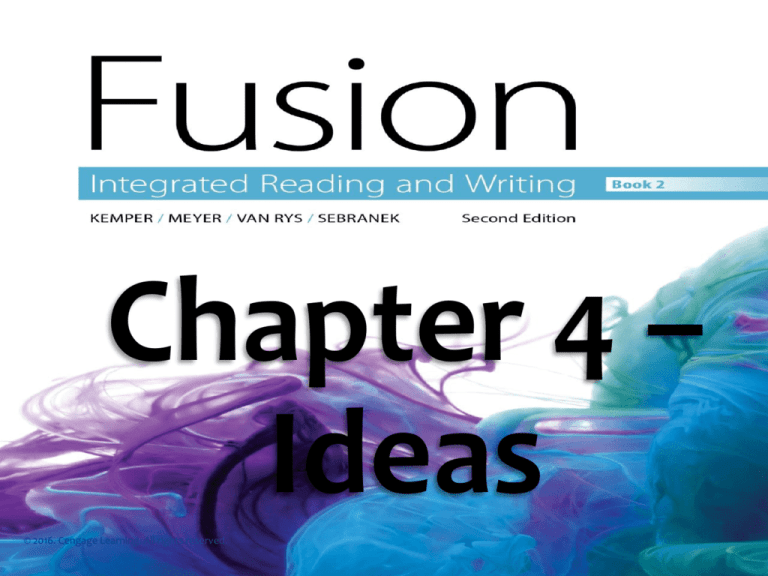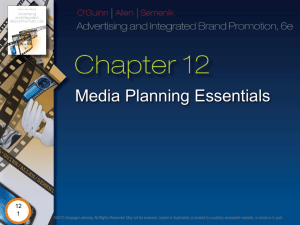
Chapter 4 –
Ideas
© 2016. Cengage Learning. All rights reserved.
Learning Outcomes
By the time you finish reading and studying
this chapter, you should be able to:
LO1 Read for topics.
LO2 Select a topic for writing.
LO3 Read for main ideas.
LO4 Establish a main idea for writing.
LO5 Read for supporting details.
LO6 Draw inferences.
LO7 Choose supporting details in writing.
© 2016 Cengage Learning®. May not be scanned, copied or duplicated, or posted to a publicly accessible website, in whole or in part.
Opening Activity
Suppose you were given the following assignment:
Select a particular experience from your life that you remember well and that has had a
significant impact on you. As you recall memorable experiences, consider those that you
remember best and that have affected you most profoundly. Through such experiences, you
may have felt excitement, joy, shock, anger, disappointment, sadness, regret, satisfaction, relief,
shame, or a mixture of feelings. Write about one particular experience that stands out, and
analyze its impact on you.
Now, let’s brainstorm some possible ideas for this essay topic:
© 2016 Cengage Learning®. May not be scanned, copied or duplicated, or posted to a publicly accessible website, in whole or in part.
Reading for Topics
Topic can be defined as what the writing is about.
When reading, the first step is to identify the topic.
Topics are often identified in the title, first few sentences,
or first few paragraphs.
Topics can be a(n):
person – Barack Obama
place – New Orleans
object – baseball bat
idea – loyalty
Bloomua, 2014 / Use under license from Shutterstock.com
© 2016 Cengage Learning®. May not be scanned, copied or duplicated, or posted to a publicly accessible website, in whole or in part.
animal – penguins
Selecting a Topic for Writing
Choosing a Topic
Writing is often tied to subjects you are studying.
Most assignments will identify a general subject area as a
starting point.
Always select a topic that interests you!
© 2016 Cengage Learning®. May not be scanned, copied or duplicated, or posted to a publicly accessible website, in whole or in part.
Selecting a Topic for Writing
Searching Strategies
Clustering – begin with the general subject in the middle, and
cluster related words around it
Freewriting – write nonstop for 5-10 minutes without
stopping to judge, edit, or correct your writing
Developing a Dialogue – create a conversation between
yourself and another person
© 2016 Cengage Learning®. May not be scanned, copied or duplicated, or posted to a publicly accessible website, in whole or in part.
Reading for Main Ideas
Main ideas are a special feature, part, or feeling
about the topic that the author emphasizes.
The main idea of a paragraph is usually found in
the topic sentence.
The main idea of an essay is usually found in the
thesis statement.
Main ideas can also be:
found in a summary statement near the end of a text.
implied or suggested, rather than directly stated.
varied in longer, more complex essays.
© 2016 Cengage Learning®. May not be scanned, copied or duplicated, or posted to a publicly accessible website, in whole or in part.
Reading for Main Ideas
In informational essays, main ideas tell you what feature of
the topic or pattern of organization will be addressed.
Example: Teenagers use and abuse drugs for many reasons, some
of which are low self-esteem, parental neglect, and peer pressure.
In argument essays, main ideas identify the claim about a
topic that the writer will argue for.
Example: The usage of steroids in high school sports is increasing
daily and must be stopped immediately.
In narrative essays, main ideas tell you how the writer feels
about the experience or event.
Example: I never truly realized the effect my parents’ divorce had
on me until I started having marriage problems of my own.
© 2016 Cengage Learning®. May not be scanned, copied or duplicated, or posted to a publicly accessible website, in whole or in part.
Reading for Main Ideas
Follow these steps to find the main idea:
1.
2.
3.
4.
5.
6.
Review the title, headings, and first and last
paragraphs.
Read the opening part for a general understanding of
the topic.
Look for a sentence or two in an opening paragraph
that directs the writing.
Underline, highlight, or write this sentence down.
Continue reading to see if that sentence makes sense
as the main idea.
If your thinking changes, write down the new main
idea.
© 2016 Cengage Learning®. May not be scanned, copied or duplicated, or posted to a publicly accessible website, in whole or in part.
Reading for Main Ideas
Topic sentences or thesis statements have 2 parts:
1.
2.
a specific topic
the author’s opinion about the topic
Do you think these are effective or ineffective thesis
statements? Why?
1.
2.
3.
I remember my first day of college like it was yesterday.
Female candidates still face challenges in U.S. elections due
to political socialization, lack of experience, and open
discrimination.
Texting and driving is a dangerous thing to do, especially for
teenage drivers.
© 2016 Cengage Learning®. May not be scanned, copied or duplicated, or posted to a publicly accessible website, in whole or in part.
Reading for Main Ideas
Implied main ideas are not directly stated in the
paragraph or essay.
When a paragraph or essay contains an implied main
idea, remember that there will be no topic sentence or
thesis statement.
Follow these steps to find the implied main idea:
1. Identify the topic.
2. Pay close attention to the details.
3. Write down the important idea that covers all the
details.
4. Read the text again, and revise if needed.
© 2016 Cengage Learning®. May not be scanned, copied or duplicated, or posted to a publicly accessible website, in whole or in part.
Activity
Activity
Look at these sets of details, and determine the implied
main idea.
An empty shopping bag on
the floor
Wrinkled jeans and
crumpled towels by the
dresser
Candy wrappers and dishes
under an unmade bed
An open dictionary, books,
and papers on the floor
Dirty socks and muddy
cleats next to a football
His lectures are well-organized
His tests are challenging but
fair
His powerpoint presentations
are creative and helpful
He’s an excellent storyteller,
sharing anecdotes about
history
Some students sit on the floor
because there aren’t enough
seats in the room
© 2016 Cengage Learning®. May not be scanned, copied or duplicated, or posted to a publicly accessible website, in whole or in part.
Establishing a Main Idea for Writing
Here are some brainstorming ideas to help you establish a
main idea for your writing.
Ideas
Description
Five W’s
Answer who, what, when , where, and why about your topic.
Add how to generate more information.
Listing
List first thoughts and questions about your topic. Record
ideas nonstop for as long as you can.
Clustering
Begin with your topic in the middle. Cluster related ideas
around it.
Focused
Freewriting
Write freely about your topic for at least 5 minutes. See
what thoughts and feelings you can uncover.
Dialoguing
Discuss your topic with another person.
© 2016 Cengage Learning®. May not be scanned, copied or duplicated, or posted to a publicly accessible website, in whole or in part.
Establishing a Main Idea for Writing
Questioning – questions can guide your search for additional
information about a topic
Choosing a focus – a strong focus or main idea helps you decide
what information to include and in what order
Forming a thesis statement – a thesis is the controlling idea in an
essay (topic + opinion = thesis)
© 2016 Cengage Learning®. May not be scanned, copied or duplicated, or posted to a publicly accessible website, in whole or in part.
Reading for Supporting Details
Supporting details are used to develop the main idea.
Major details explain or illustrate the main idea.
Minor details complete or clarify the major details.
Here are some types of details often included in writing:
Facts and statistics
Anecdotes
Quotations
References
Analysis
Explanations
Examples
Definitions
Reasons
Reflections
Descriptions
© 2016 Cengage Learning®. May not be scanned, copied or duplicated, or posted to a publicly accessible website, in whole or in part.
Reading for Supporting Details
It is also important to evaluate details that you read.
Use the following criteria to decide if you can trust
the details in your reading:
The source is a textbook, or the reading comes from a
respected publisher, periodical, or domain (.edu, .org,
.gov)
The author is identified and writing in the field of
expertise.
The topic is covered in-depth, information is balanced
and timely, and reading is clear and logical.
© 2016 Cengage Learning®. May not be scanned, copied or duplicated, or posted to a publicly accessible website, in whole or in part.
Drawing Inferences
An inference is a logical conclusion made about
something not actually stated.
To make a thoughtful inference:
1. carefully read and reread the text.
2. identify the main idea and supporting details.
3. then ask, What other conclusions can I draw?
What can you infer from these pictures?
Alexey Losevich, 2014 / Use under license from Shutterstock.com
Hurst Photo, 2014 / Use under license from Shutterstock.com
Vereshchagin, 2014 / Use under license from Shutterstock.com
© 2016 Cengage Learning®. May not be scanned, copied or duplicated, or posted to a publicly accessible website, in whole or in part.
Choosing Supporting Details for Writing
When planning a piece of writing, you need to:
Select a topic
Gather details about the topic
Form a thesis or focus for writing
Decide how best to the use the details
© 2016 Cengage Learning®. May not be scanned, copied or duplicated, or posted
to a publicly accessible website, in whole or in part.
wavebreakmedia, 2014 / Use under license from Shutterstock.com
1.
2.
3.
4.
Closing Activity
Together, let’s try to identify a focus and thesis statement
for the following topics.
1. A problem in today’s schools
Focus:
Thesis:
2. Salaries of professional athletes
Focus:
Thesis:
3. Social networking
Focus:
Thesis:
4. Sex in the media
Focus:
Thesis:
Quka, 2014 / Use under license from Shutterstock.com
© 2016 Cengage Learning®. May not be scanned, copied or duplicated, or posted to a publicly accessible website, in whole or in part.
Closing Activity
Look at the following main ideas and supporting details.
Decide which details would best support the main ideas.
Online shopping offers many benefits.
You can shop anytime.
You can’t try clothes on to see if they fit.
You don’t have to leave home.
You have to pay expensive postage to return items.
Physical appearance should be a primary factor in hiring employees.
More attractive people can generate more business for a company,
especially for those involving customer service or sales.
Attractive people are more intelligent and competent than nonattractive ones.
Attractive people don’t work as hard as their less attractive
counterparts.
People are generally drawn to beautiful faces, which can increase
company profit.
© 2016 Cengage Learning®. May not be scanned, copied or duplicated, or posted to a publicly accessible website, in whole or in part.








